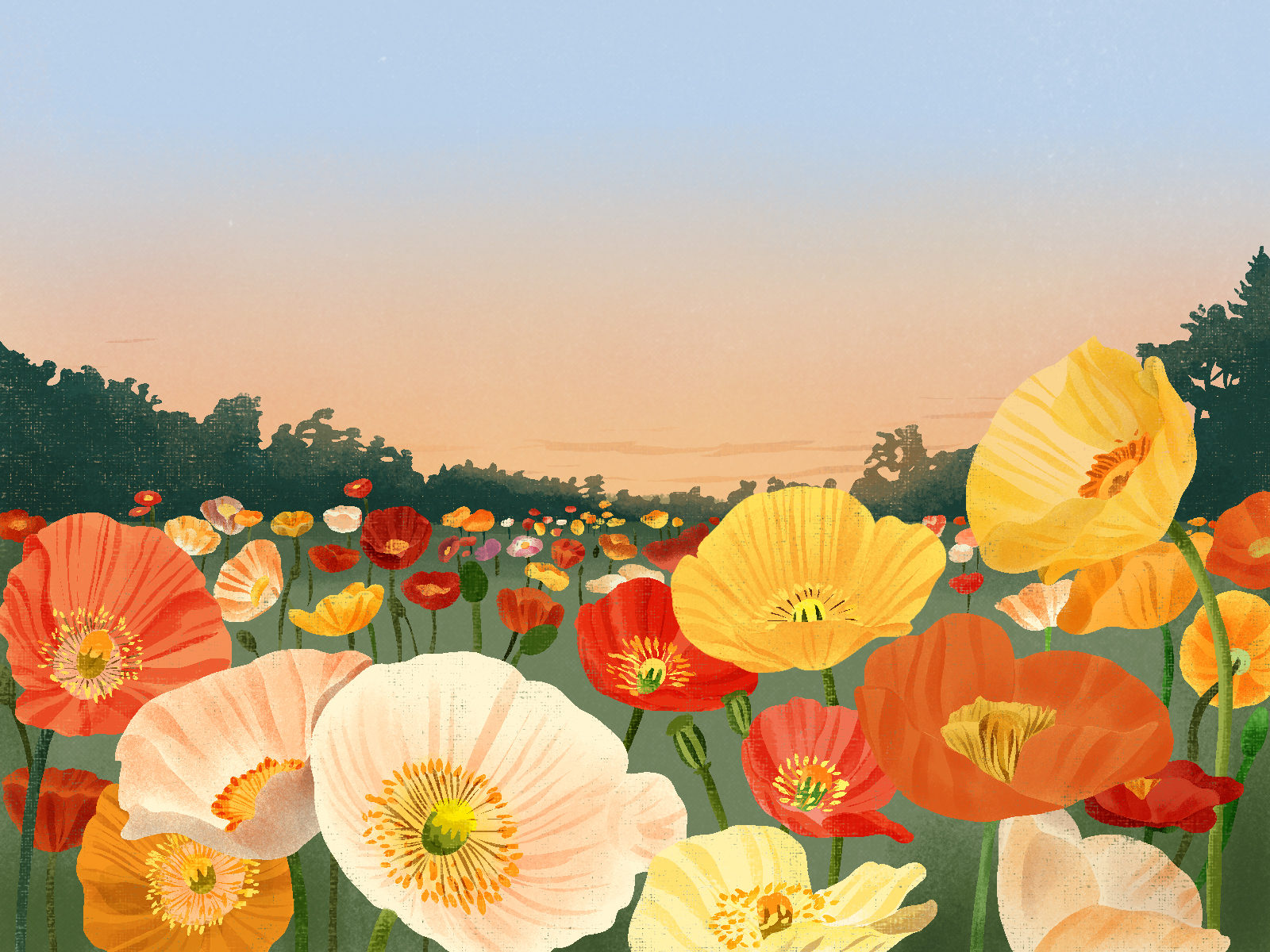Best of the Haiku Challenge (March 2022)
Announcing the winning poems from Tricycle’s monthly challenge The post Best of the Haiku Challenge (March 2022) appeared first on Tricycle: The Buddhist Review.

 Illustration by Jing Li
Illustration by Jing LiIt can be difficult to compress the truth of world events into the seventeen-syllable frame of haiku. But it is not impossible. A haiku is bigger on the inside than it is on the outside, a small world that can contain an unlimited range of human thoughts and emotions—provided it remains grounded in images from the natural world.
The winning and honorable mention haiku for last month’s challenge employed the haiku form to contain the large-scale realities of life in 2022.
Lisa Anne Johnson uses a train “fleeing” through a rainy sunrise to bring us face to face with the human cost of war. Susan Polizzotto’s spring sunrise explores every crack and fissure of a bleached skull . . . that might be animal or human. Lynn Wagner sets haiku on a scale with the best modern news photography in her portrait of “war mothers” at first light.Congratulations to all! To read additional poems of merit from recent months, visit our Tricycle Haiku Challenge group on Facebook.
You can submit a haiku for the April challenge here.
***
WINNER:
rainy spring sunrise —
each droplet on the windows
of the fleeing train
— Lisa Anne Johnson
There is an implicit bias in Japanese haiku against addressing matters of urgent moral concern. As recently as 2012, Haiku International Association president Akito Arima wrote: “Haiku is about nature and the seasons; there is no need to discuss or comment on difficult or delicate issues. To confront is not its goal, but instead to bring harmony.”
In terms of her haiku philosophy, the winner of our March 2022 haiku challenge couldn’t represent a more different point of view. A biologist and poet, Dr. Lisa Anne Johnson strives to write haiku that address the decline of nature during the Anthropocene. In 2021, she founded a short-form poetry magazine called Trash Panda, named for the common raccoon, which she describes as “a resilient adapter, thriving in the face of human destruction and interference.”
Why would a poet concerned with the decline of the natural world choose an art form that, by its very nature, tends to focus on the beauty and harmony of nature? Perhaps there is no better form than haiku for bearing witness to a world in travail.
In the submission guidelines for Trash Panda, Johnson writes: “Poems should witness nature as it exists today. Plastic bags may flutter from cherry trees, and herons may stand in filthy water.” She might have added that the most honest way to celebrate a spring sunrise in 2022 is by juxtaposing it with horrors of war.
And yet, Arima is correct on one point: to confront is not the goal of haiku. There is no room for a formal, organized protest in seventeen syllables. What we can do is “witness nature as it exists today,” even if that means opening our eyes (and the eyes of our readers) to truths we would rather not see.
When a haiku poet wants us to feel something deeply, she will hold back a little, inviting us to step closer, as it were, to the concrete images of the poem.
As the sun rises on a spring morning, with some parts of the world still sleeping and others already going on with their day, a train covered in raindrops is “fleeing.” Faced with the impossibility of describing the emotional devastation and physical dislocations of the war in Ukraine, the poet has exercised restraint, focusing on the train, the raindrops, and the spring sunrise.
When a haiku poet wants us to feel something deeply, she will hold back a little, inviting us to step closer, as it were, to the concrete images of the poem. In this case, we are asked to consider each raindrop on the windows of the train.
At first that is all we see. The ten thousand sunlit droplets, shivering on the surface of the glass. Then, suddenly, we see past them to the interior of the train—and peer right into the faces of the refugees.
We are so close. Except for the glass, we are eye to eye with them now. That is the dark genius of this sad and beautiful poem.
HONORABLE MENTIONS:
spring sunrise explores
the hairline cracks and fissures
of a whitened skull
— Susan Polizzotto
A pale spring sunrise
lights the work of war mothers
combing for remains.
— Lynn Wagner
♦
You can find more on March’s season word, as well as relevant haiku tips, in last month’s challenge below:
Spring season word: “spring sunrise”
Although it seems slow
the spring sunrise is moving
at the speed of light
Science makes good poetry, provided it doesn’t pretend to explain everything. Astronomy is an endless source of wonder for me. For that reason, I feel especially drawn to season words from the category that Japanese haiku poets call “the heavens.”
Submit as many haiku as you wish that include the season word “spring sunrise.” Your poems must be written in three lines of 5, 7, and 5 syllables, respectively, and should focus on a single moment of time happening now.
Be straightforward in your description and try to limit your subject matter. Haiku are nearly always better when they don’t have too many ideas or images. So make your focus the season word and try to stay close to that.
REMEMBER: To qualify for the challenge, your haiku must be written in 5-7-5 syllables and include the words “spring sunrise.”
HAIKU TIP: SAY IT WITH SCIENCE!
Western haiku poets are often surprised to discover that Akito Arima (1930-2020), president of the Haiku International Association for many years, was also a nuclear physicist and former president of Tokyo University. Director of the Japan Science Foundation, he also served as Japan’s Minister of Education. But Japanese poets are not in the least surprised by Arima’s interest in haiku. A literary art form that takes decades to master, haiku is a popular pastime open to people from all walks of life. It is a way to relax and reconnect with nature, with one another, and with ourselves.
Outside of Japan, Arima is most famous for his development of the Interacting Boson Model, used to predict the behavior of subatomic particles. Not surprisingly one of his most famous haiku pays tribute to the father of theoretical physics.
Under Sirius,
Dog Star, Einstein’s century
has come to an end
Notice the collision of images in the poem. “Einstein’s century” (the century of unprecedented technological growth for which his ideas laid the foundation) is juxtaposed with the “Dog Star” Sirius, part of a constellation with rich mythological and cultural associations, and also the brightest star in the sky. The achievements of human beings, of human progress itself, exist against the backdrop of time and space so vast that it reveals them in perspective. Arima’s understanding of science is tempered by his devotion to an art form that does not place human beings at the center of the universe.
Asked in a 2012 interview if the arts and sciences were of equal value to him (“Do your physics and your haiku compete with one another or ‘love each other dearly’?”), Arima replied at length:
If I am interested in the physics at hand, I continue to work ten hours, one hundred hours, no problem. But sometimes I have trouble solving my own questions. Nature is very cunning in hiding her secrets. In that case, I go back to haiku. I look at the other side of nature. Then, she frankly tells me her beauty. I turn from physics and very detailed theory to gigantic scenery or the detailed beauty of flowers or the beautiful song of the insect. I write a haiku. Then my energy concerning physics comes back. Then I look at my problem again with different eyes. Then I can suddenly find the heart of a secret of nature.
Sometimes I have difficulty finding little poems, little haiku, so even after two or three hours I cannot write a good haiku at all. Then I go back to my studio to study physics. So both of them help each other very much. Physics, or more generally science, and haiku, or more generally arts, both of them show us different faces of nature. One is the beautiful side of nature; the other is a very delicate fine structure of nature. There is no conflict between haiku and physics.
And so, there really is no discontinuity between the haiku’s animistic approach to nature (which Arima often championed in his writings) and a close examination of nature using physics, botany, ecology, etc. At the very least, the two can inform one another. At their best, they are like two sides of a single coin.
A note on the spring sunrise: The days grow progressively longer throughout the springtime, which is determined in astronomical terms as beginning with the spring equinox in March and ending in June with the summer solstice, the longest day of the year. Spring sunrises invite a hopeful mood. The knowledge that the earth is growing warmer, the days fuller, is written in our bones.

Get Daily Dharma in your email
Start your day with a fresh perspective

Explore timeless teachings through modern methods.
With Stephen Batchelor, Sharon Salzberg, Andrew Olendzki, and more
![]()
Thank you for subscribing to Tricycle! As a nonprofit, we depend on readers like you to keep Buddhist teachings and practices widely available.
This article is only for Subscribers!
Subscribe now to read this article and get immediate access to everything else.
Already a subscriber? Log in.

 Kass
Kass 

























![Run An Ecommerce SEO Audit in 4 Stages [+ Free Workbook]](https://api.backlinko.com/app/uploads/2025/06/ecommerce-seo-audit-featured-image.png)





